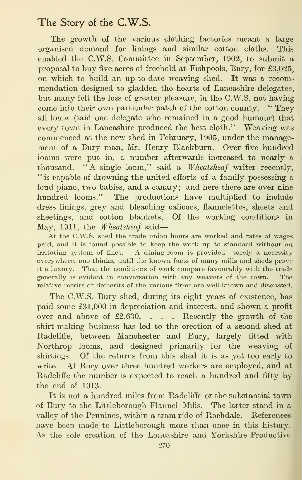Page 344 - The_story_of_the_C._W._S._The_jubilee_history_of_the_cooperative_wholesale_society,_limited._1863-1913_(IA_storyofcwsjubill00redf) (1)_Neat
P. 344
The Story of the CW.S. —
The growth of the various clothing factories meant a large
organised demand for linings and similar cotton cloths. This
enabled the C.W.S, Committee in September, 1902, to submit a
proposal to buy five acres of freehold at Fishpools, Bury, for £3,025,
on which to build an up-to-date weavmg shed. It was a recom-
mendation designed to gladden the hearts of Lancashire delegates,
but many felt the loss of greater pleasure, in the C.W.S. not having
come into their owii particular patch of the cotton county. " They
all knew (said one delegate who remained in a good humour) that
ever}' iovm in Lancashire produced the best cloth." Weaving was
commenced at the new shed in February, 1905, under the manage-
ment of a Bury man, Mr. Henry Blackburn. Over five hundred
looms were put in, a number afterwards increased to nearly a
thousand. "A single loom," said a Wheatsheaf wTiter recently,
" is capable of drowning the united efforts of a family possessing a
loud piano, two babies, and a canary; and here there are over nine
hundred looms." The productions have multiphed to mclude
dress linings, grey and bleaching calicoes, flannelettes, sheets and
sheetings, and cotton blankets. Of the working conditions in
May, 1911, the Wheatsheaf said
At the C.W.S. shed tlie trade union hours are worked and rates of wages
paid, and it is found possible to keep the work up to standard without an
irritating system of fines. A dining-room is provided—surely a necessitj'
everywhere, one thinks, until the known facts of many mills and sheds prove
it a luxury. That the conditions of work compare favourably with the trade
generally is evident in conversation with any weavers of the town. The
relative merits or demerits of the various firms are well-known and discussed.
The C.W.S. Bury shed, during its eight years of existence, has
paid some £31,000 in depreciation and interest, and shown a profit
over and above of £2,630. . . . Recently the growth of the
shirt-making business has led to the erection of a second shed at
Radchffe, between Manchester and Bury, largely fitted with
Northrop looms, and designed primarily for the weaving of
shirtings. Of the returns from this shed it is as yet too early to
write. At Bury over three hundred workers are employed, and at
Radchffe the number is expected to reach a hundred and fifty by
the end of 1913.
It is not a hundred miles from Radchffe or the substantial town
of Bmy to the Littleborough Flannel Mills. The latter stand in a
vaUey of the Pennines, within a tram ride of Rochdale. References
have been made to Littleborough more than once in this history.
As the sole creation of the Lancashire and Yorkshire Productive
270

